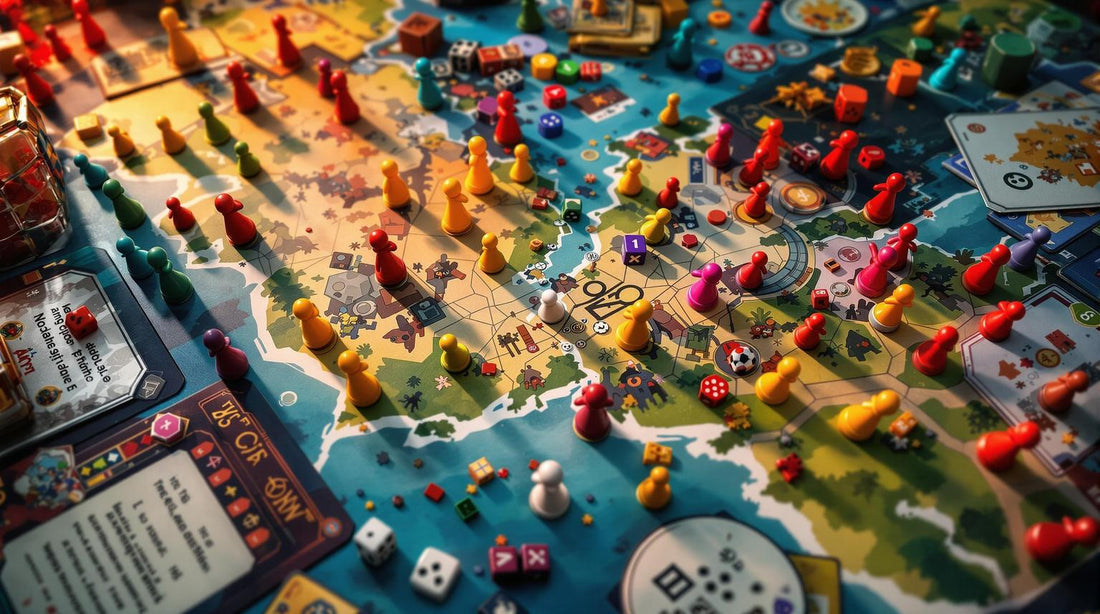Discover the Best Board Games for Every Player

Player Priority Rules Explained
Player priority rules are crucial in board games for fairness, strategy, and smooth gameplay. They determine who acts first, how turns are structured, and how conflicts are resolved. Here's a quick breakdown:
- Why They Matter: Influence resource access, action timing, and strategy shifts.
-
Common Types:
- Clockwise turns (Catan)
- Action points (Pandemic)
- Stack-based systems (Magic: The Gathering)
- Starting Priority: Methods include dice rolls, thematic criteria, or random draws.
- Dynamic Turn Order: Some games adjust priority based on actions (Power Grid) or bidding (Cyclades).
- Conflict Resolution: Systems like APNAP (Active Player, Non-Active Player) clarify who acts first in overlapping scenarios.
Quick Tip: Understand turn order mechanics to plan better, adapt strategies, and maximize your advantage in every phase of the game.
Turn Order Systems in Tabletop Games
Understanding Priority Rules
Priority rules are the backbone of structured turn-based games, providing a clear framework for how players interact. These can range from straightforward clockwise turns to more intricate systems involving multiple layers of responses.
Why Priority Rules Matter
Priority rules are essential for keeping gameplay smooth and organized. They ensure every player gets an equal opportunity to act, avoid timing disputes, and allow for strategic decision-making based on turn order. By having clear guidelines, players can focus on the game itself rather than worrying about procedural confusion.
Common Priority Rules
| Priority Type | Example Game and Application |
|---|---|
| Turn Order | Catan - Trading and building follow a strict clockwise sequence |
| Action Points | Pandemic - Each player gets 4 actions per turn |
| Stack-Based | Magic: The Gathering - Uses a detailed system for passing priority |
For instance, in Magic: The Gathering, the active player has priority first during each phase of the game. Actions are resolved in reverse order, creating a layered and tactical approach to gameplay. This highlights how priority rules can adapt to both casual and competitive environments.
Setting Player Priority
Managing player priority effectively can shape the flow and strategy of a game. Many modern games use creative methods to decide and adjust turn order, keeping gameplay engaging and balanced.
Starting Priority
Determining who goes first is often simple, but the methods can vary. A classic example is the dice roll, as seen in Catan, where players roll two dice, and the highest roll starts. Other games take different approaches:
| Method | Example Games | How It Works |
|---|---|---|
| Thematic Criteria | Ticket to Ride | The most experienced traveler begins. |
| Random Draw | 7 Wonders | Players draw cards to decide the first turn. |
| Age-Based | Various | The youngest or oldest player starts. |
Changing Priority
Some games introduce dynamic systems to adjust the turn order based on in-game actions or conditions. For instance, Power Grid changes priority depending on how many cities a player powers, encouraging strategic decisions and creating opportunities for others to catch up.
Bidding systems are another method. In Cyclades, players auction for the favor of Greek gods, which influences both turn order and available actions.
"The player order rotates each round, but the last player gets a bonus power token, balancing the advantage of going first", explains the designer of Terra Mystica.
Games like Twilight Imperium take a unique approach by using strategy cards. These cards not only determine turn order but also grant special abilities. Meanwhile, fixed seating games often include balancing mechanisms. For example, Puerto Rico gives players starting later an extra amount of money.
These systems add layers of strategy and become essential when resolving conflicts over who takes the next move.
Solving Priority Conflicts
When dynamic turn order systems create overlapping actions, having a clear way to resolve these conflicts is essential. A well-defined process ensures disputes are avoided and gameplay stays smooth.
Priority Order Steps
A widely used method for handling priority conflicts is the "Active Player, Non-Active Player" (APNAP) principle. This framework clarifies who acts first when multiple actions are possible at the same time.
| Priority Level | Who Acts | Example |
|---|---|---|
| Primary | Active Player | The player whose turn it is |
| Secondary | Next Player Clockwise | Reaction timing in MTG |
| Tiebreakers | Game-Specific | Initiative values in Gloomhaven |
Priority in Practice
Games like Gloomhaven use variable initiative systems to address priority conflicts effectively. In combat, actions are resolved based on initiative values on ability cards, with lower numbers going first. This system ensures a clear, structured order, even during complex scenarios.
Key points to keep in mind:
- Game-specific rules override general priority guidelines.
- Passive abilities might activate without requiring priority to pass.
- Tiebreakers are often tailored to the mechanics of individual games.
- Resource conflicts should always follow the established priority system.
Physical tools, such as numbered tokens, can help manage intricate sequences, especially in games with multiple action phases or heavy combat mechanics.
sbb-itb-1ed942f
Tips for Using Priority Rules
Once conflicts are resolved, knowing how to make the most of priority rules can give you an edge in board games. These rules often shape your strategy and decision-making, especially in games where timing and order matter.
Turn Order Planning
Your position in the turn sequence plays a big role in shaping your strategy. In games where resources are limited, players who go later might benefit more by focusing on less-contested areas instead of competing for the most sought-after spots. Use your turn order to guide decisions about how to manage and allocate resources effectively.
Changing Turn Order
Some games allow you to adjust turn order, adding another layer of strategy. For example, Viticulture uses a wake-up track system where players can choose to act earlier by giving up bonus resources. This creates a tough choice: is it better to go first or to secure extra rewards? Understanding when to prioritize an earlier turn can make a big difference.
End Game Priority
As the game nears its conclusion, your position becomes even more critical. In Terraforming Mars, for instance, the final generation often determines the winner. Your turn order can impact your ability to claim last-minute milestones or awards, so planning ahead is key.
To make the most of your priority in the endgame:
- Keep track of how many actions remain.
- Position yourself to take advantage of scoring opportunities.
- Be mindful of when and how the game will end to maximize your points.
When using APNAP principles for multi-turn strategies, think about how your choices now will influence both short-term tactics and your overall path to victory.
Key Points About Priority Rules
Priority rules are essential in shaping strategic gameplay in board games. They influence everything from how resources are managed to how players interact, ensuring a balanced and engaging experience. By defining clear action sequences and decision-making frameworks, these rules directly impact strategies discussed in sections like Turn Order Planning and Conflict Resolution.
These systems often evolve by building on familiar priority mechanisms while introducing new strategic layers. For example, Scythe links turn order to specific worker placement choices, while Terra Mystica separates build and income phases with distinct activation orders.
Key Design Functions of Priority Rules
- Balancing Advantages: Catch-up mechanics help level the playing field.
- Structuring Gameplay Flow: Reduces downtime and keeps the game moving smoothly.
- Encouraging Strategy: Predictable sequences allow players to plan and adapt.
Modern board games use priority rules in diverse ways to achieve specific goals. These approaches add depth without disrupting the overall flow of gameplay.
Priority Rules in Action
| Function | Impact on Gameplay |
|---|---|
| Balance | Reduces first-player advantage by incorporating catch-up mechanisms |
| Engagement | Builds tension through strategic decisions tied to turn order |
| Flow | Ensures smooth gameplay by minimizing downtime between player turns |
| Strategy | Promotes planning and flexibility as priorities shift during the game |
Take 7 Wonders as an example: its draft-dependent turn order determines when players gain access to resources. Understanding these mechanics can greatly enhance your decision-making during gameplay.
Find Games at Brain Games

Learning about priority rules becomes much more fun when you can see them in action. Brain Games offers a wide range of turn-based board games, each highlighting different priority systems. These games give players a hands-on way to explore the concepts discussed in this guide.
If you're just starting with priority-based games, Brain Games has options for all experience levels. Each game comes with detailed descriptions of its mechanics, helping you pick one that matches your preferred complexity and play style.
The staff can also recommend games tailored to your interests and skill level, reinforcing the ideas covered earlier. Plus, regular game nights provide a chance to see these priority systems in action and learn through play.
What’s Coming Next in Priority Systems
Brain Games is constantly updating its collection with new titles that bring fresh twists to turn order mechanics. For example, Chronoscape, set to launch in mid-2025, will feature a dynamic system where turn order shifts based on players' positions across timelines. Another upcoming title, EcoSphere, ties turn order to choices in managing environmental resources.
You can use their filters for game mechanics and player count to find the perfect match. And if a game doesn’t meet your expectations, their two-week exchange policy has you covered.
FAQs
What are the rules for holding priority in Magic: The Gathering?

Magic: The Gathering uses a stack-based system to manage priority, ensuring players take turns making decisions during each phase of the game. The active player always gets priority first after resolving any automatic turn-based actions. If a player wants to act before passing priority, they must explicitly declare "hold priority."
Here are some important points about priority in Magic: The Gathering:
- Certain actions skip the priority process entirely.
- Actions like turning face-down creatures face up don't involve the stack and don't require passing priority.
For new players, practicing priority timing and clearly stating intentions during complex plays can help improve their understanding of the game's strategic timing. This ties into the broader concept of planning your moves during each turn.






